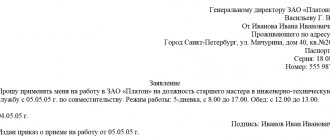Example of an acquaintance certificate
Limited Liability Company "PreStol"
TIN 26938546 OGRN 6694556843136,
legal address: 440018, Russia, Penza, st. 30 Let Oktyabrya, 302, off. 59
Familiarization certificate
August 17, 2021 Penza city
Time for drawing up the act: 09 hours. 35 min. (local time)
I, the head of the personnel department of the Limited Liability Company "PreStol" Yurkovich Valentin Stepanovich, in the presence of the head of the marketing department of the Company, Daria Sergeevna Maximova and the specialist of the personnel department, Evgenia Nikolaevna Novoseltseva, have drawn up this act that:
August 17, 2021 at 09 a.m. 35 min. local time, the order of the director of the Company No. 97 l/s dated 08/16/2017 on attracting the specified employee to work on the day off August 26, 2021 was brought to the attention of Valery Viktorovich Krivko, an employee of the marketing department.
A copy of the order was received by Valery Viktorovich Krivko on August 17, 2017.
I have read the contents of the order and a copy has been received by: Krivko V.V.
The contents of the act are confirmed by personal signatures:
Head of Marketing Department Maksimova D.S.
HR Department Specialist Novoseltseva E.N.
This act was made
Head of HR Department Yurkovich V.S.
Help: Mark on familiarization with the document
On this basis, the court upheld the decision of the state labor inspector with changes only in part of the imposed administrative penalty. Thus, the fine was reduced to 30,000 rubles (decision of the Moscow Regional Court dated June 24, 2014 in case No. 21-590/2014).
As a rule, on the first working day, all employees become familiar with a number of local regulations of the company, given that this rule is enshrined in the law.
I don’t see any particular need to renegotiate the contract - because your terms of the contract have not changed...
Among the responsibilities of most HR specialists is not only caring for personnel and correct maintenance of personnel documentation, but also submitting reports. Questions regularly arise about what specific reports a HR specialist needs to make. In order not to miss a single report, we suggest using the calendar we have developed.
When to draw up an acquaintance certificate
The obligation to familiarize a person with the contents of a certain document is often assigned to a person in connection with the performance of his work duties. Familiarize the employee with the order, job description, the offender with the protocol on the administrative offense, with the materials of the case regarding the complaint to the state body upon receipt of the corresponding application, etc.
An act of familiarization is often drawn up when it is not the interested person himself who gets acquainted with the materials, but a representative by proxy.
Since acts are documents whose essence is to record a certain fact, it is better to prepare them with the involvement of witnesses (at least 2). Information about the persons present is entered into the act and certified by signatures.
Order of dismissal: how many days in advance is it issued?
In this article we will talk about one of the most important secretarial duties - familiarizing employees with the document for signature. Let's figure out how to register an acquaintance mark and what acquaintance options exist.
As a general rule, the employee will be subject to the provisions of the LNA from the moment he becomes familiar with it. Let's consider a case from practice.
When hiring, the Employer is obliged to familiarize the employee with these rules and other local regulations related to the employee’s labor function.
What is stated in the act
If an employee does not want to sign or, in principle, does not intend to get acquainted with the contents of the order, notification, instruction, order or instruction, then a special paper is drawn up about this. It should contain:
- Full name and position of the employee who refuses to familiarize himself with the order (or put his signature on the documents);
- Full name of the person drawing up the document (often this is a personnel department employee, accountant or other official responsible for familiarizing employees with orders);
- positions, surnames, first names and patronymics of employees who will attest to the fact of categorical refusal (at least three people);
- place and date of compilation;
- name of company;
- if possible, exact time;
- number and date of the document due to which the dispute occurred;
- personal signatures of the persons who witnessed the act.
Also in the above form there are several blank lines to explain the motivation of the employee who refused. If the reasons were not given, then a dash is placed in these columns. If they were expressed at least orally, then these justifications can be written down by the document compiler who heard them.
If the employee has read the provided paper, but has not put the required reading mark, this act is also drawn up.
Compilation rules
When filling out, it is fundamentally important to take into account the timing. The more accurately the time is specified, the better. In court, questions will be asked regarding time periods and testimony will be compared. It is also advisable to mention in the text where the order was read (office, HR office, manager’s office, etc.).
It is acceptable to ask the question orally or read the document out loud to the employee. The main thing is that the refusal is clear. The text of the act may sound like this:
“I, the head of the HR department, Vasily Ivanovich Tarasov, in the presence of the cleaner Elena Vitalievna Markova and the manager Ivan Sergeevich Knyazev, have drawn up this act stating that...”
Employees or persons who agreed to record the fact of refusal must also be present in this room and clearly understand that the employee refused to read the order and sign on it. Witnesses must sign to confirm this fact. Only in this case will the act have legal force. If the employee refused to sign this document, then this can be written at the very end of the act. There is no need to draw up a separate document regarding refusal to sign.
Specific example and wording
Suppose an employee should be fired due to absenteeism. But he refuses to sign any documents. In this case, you need to draw up a memo, fill out an absenteeism report (failure to show up for work), try to get an explanatory note (or draw up an act of refusal to draw it up), and issue a dismissal order. And only if the employee does not familiarize himself with the dismissal order (expressing this at least verbally), then a certificate of refusal to familiarize himself with the order is filled out.
An arbitrary form of compiling this paper is also acceptable, but it must contain all the above-mentioned information and details.
Thus, the form and sample provided for downloading are a good help for the personnel worker. There is no need to reinvent the wheel with them. Simply fill in the empty columns that describe the “actors” and the current situation. In this case, you must strictly adhere to the deadlines provided for by labor legislation.
At what stage does the job description become familiar?
The same principle was followed by personnel officers in their time: the older generation remembers multi-page questionnaires with questions like “Was your grandfather in the occupied territory?” Nowadays, excessive curiosity can be very costly for an employer.
Also, an equally important factor is to ensure the execution of such an order by all employees or employees on whom its timely and accurate execution depends.
The employer’s responsibility is not only to competently and correctly draw up the document, but also to communicate it to the employee. If there is no reading visa, then the personnel service and management will not be able to confirm the fact of familiarization.
The employer does not have the right to force an employee to sign the sheet of familiarization with the order. In case of refusal to familiarize yourself with the administrative documents, the representative of the company draws up an act of refusal to execute the decision of the head of the legal entity. On its basis, the director can impose disciplinary measures on the employee, up to and including dismissal.
Shelf life
According to existing legislation, the act must be stored in the organization (its archives department, safe, etc.) for three years. This is the case if employees do not work in hazardous conditions.
If the employee does not want to sign to familiarize himself with the order, in this case, a Certificate of Refusal to familiarize himself with the order is drawn up. Such a document must be drawn up in all such cases to record cases of refusal. The development of events may be different, including resolution of disputes between the employee and the employer in court. Any document confirming the employer’s correctness can play a positive role in the consideration of the case.
Please, should I have been familiarized with the act of absence from work? | Barnaul
Labor Code of the Russian Federation:
Article 81. Termination of an employment contract at the initiative of the employer.
An employment contract can be terminated by the employer in the following cases:
6) a single gross violation of labor duties by an employee: a) absenteeism, that is, absence from the workplace without good reason throughout the entire working day (shift), regardless of its duration, as well as in the case of absence from the workplace without good reason more than four hours in a row during a working day (shift)…
In this case, there will be a disciplinary sanction in the form of dismissal. It should be borne in mind that an employee cannot be subject to disciplinary action for refusing to perform work in the event of a danger to his life and health - if he suddenly fell ill, but was unable to go to the clinic that day, he may have called an ambulance ... Before dismissing, you should take an explanatory note about the reasons for absence...
It should be borne in mind that: a) the monthly period for imposing a disciplinary sanction must be calculated from the date the offense was discovered; b) the day of discovery of the misconduct, from which the month period begins, is considered the day when the person to whom the employee is subordinate for work (service) became aware of the commission of the misconduct, regardless of whether he was vested with the right to impose disciplinary sanctions; c) the one-month period for applying a disciplinary sanction does not include the time of illness of the employee, his stay on vacation, as well as the time required to comply with the procedure for taking into account the opinion of the representative body of employees (part three of Article 193 of the Labor Code of the Russian Federation); the absence of an employee from work for other reasons, including in connection with the use of rest days (time off), regardless of their duration (for example, with a rotational method of organizing work), does not interrupt the flow of the specified period...
And further. The employer must comply with the general principles of legal, and therefore disciplinary, liability, such as fairness, equality, proportionality, legality, guilt, humanism.
For these purposes, in the event of a legal dispute, the employer must provide evidence indicating not only that the employee committed a disciplinary offense, but also that when imposing a penalty, the severity of this offense and the circumstances in which it was committed were taken into account (part five of Article 192 Labor Code of the Russian Federation), as well as the employee’s previous behavior and attitude towards work.
If, when considering a case for reinstatement at work, the court comes to the conclusion that misconduct actually occurred, but the dismissal was made without taking into account the above circumstances, the claim for reinstatement at work may be satisfied.
Treat the employee with respect, and not like a master treats a slave - in the end, he creates material values for you and higher well-being... Find out the reasons for absenteeism, sort it out as a human being, after all, he was absent for 1 day, not a week, weigh the pros and cons...
Why is it necessary to draw up an act of refusal to familiarize yourself?
The main purpose of this document is to record the employee’s refusal to familiarize himself with the manager’s order, and the employee must notify his reluctance at least verbally. This measure is necessary to prevent possible controversial situations between the employee and the organization. Any additional document will outweigh the correct actions in your favor. And in any proceedings, such documents will allow you to defend your position.
There can be quite a few situations, the most common being a negligent attitude towards fulfilling one’s job duties, and also allowing oneself to exhibit constant violations of labor discipline or systematic tardiness and absenteeism at work.
To make a decision to dismiss such an employee for absenteeism, a number of actions are required, for example, a report on his absence from work is drawn up. An order is issued to impose a disciplinary sanction on the employee, which he refuses to sign, at which point you will need such an act.
Familiarization with local acts (Suverneva A.I.)
I agree with my colleague – this is really good advice. List of taxpayers who are not supposed to apply...
Pay special attention to familiarize employees with orders regarding penalties. This is due to the fact that the Labor Code of the Russian Federation in Art. 193 establishes clear deadlines for familiarization with such orders: “An order (instruction) of the employer to apply a disciplinary sanction is announced to the employee against signature within three working days from the date of its publication, not counting the time the employee is absent from work.
If the procedure for familiarization established by law is violated, the document may not come into force. This applies, in particular, to orders to impose penalties.
In the event that such a fact occurs, employees of the organization can send a complaint to the relevant authorities, and as a result of the proceedings, the least punishment may be bringing the organization's management and officials to administrative responsibility.
How to draw up an act of refusal to familiarize yourself
- Information about the author of the act – full name and position.
- Information about the person who refuses to sign the order - full name and position.
- When drawing up the document, the witnesses to this refusal must be indicated, indicating their positions and full names.
- Time and place of drawing up the act.
- The details of the order must be indicated - the date of its preparation and its number.
- If the reason for refusal is known, it must be reflected in the act.
- The act must be certified by at least two witnesses.









